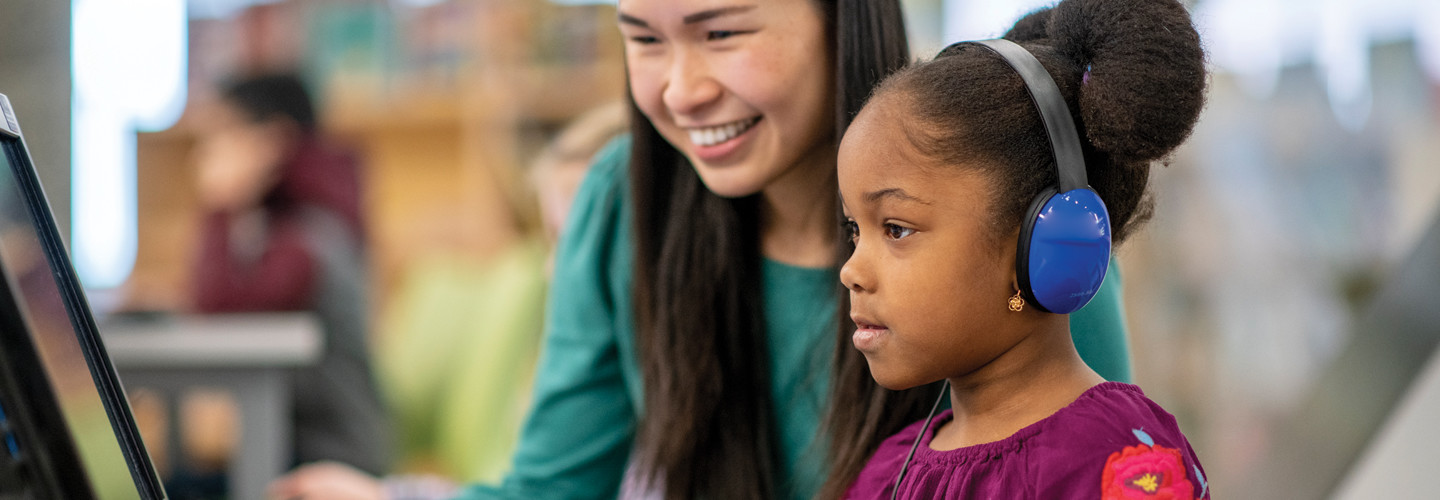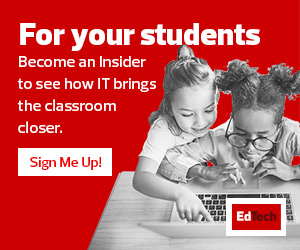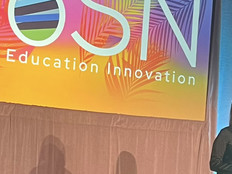1. Incorporate UDL in Environmental Design
Examining environments is the first step toward ensuring we don’t create barriers for stakeholders but instead create welcoming learning spaces for everyone. It’s important to do this in our offices, community spaces and classrooms.
In our workspaces, images and text in multiple languages show students and staff how and where to get help. Our spaces are well lit, and help desks are arranged so attendants can see eye to eye with people who enter. These simple steps engage customers and allow everyone to navigate our offices to find the services they need.
In designing our classrooms, Bartholomew Consolidated Schools has invested in large digital displays and enhanced sound systems, including voice amplification for teachers.
In a 1,000-square-foot classroom — whether the room is square, wide or deep — a 100-inch digital display is large enough that 92 percent of students will be within an acceptable viewing distance, according to a study by PKE. Conversely, a 65-inch display can be easily viewed by only 27 percent of students, on average. Classrooms designed so every student can see the display increases not only engagement and learning, but inclusivity and accessibility as well.
Investing in enhanced sound can also improve student learning, comprehension and behavior. A TeachLogic study reported that learning outcomes increase by 15 percent when teachers use sound amplification in their classrooms. Educators who rely on their “teacher voice” simply do not reach every student.
With the right tools, including large displays and audio amplification, educators can keep everyone in the room engaged in learning.
DIVE DEEPER: Discover the 3 things to know about audio in the K–12 classroom.
2. Clarify Communication Within District Departments
Communication is crucial for a technology department’s success. As the district’s technology director, I need to explain complex systems concisely and effectively to stakeholders who have little to no background knowledge in technology.
Communication is important within departments as well. Text-heavy emails are rarely effective. Simple, practical steps embedded in the UDL framework show that information represented using symbols, tables, audio, video and images help everyone. Imagine being able to read through the text, not really understanding it, but then being able to look at a diagram or video to help your comprehension. This can improve communication and understanding in people at all levels of K–12 education, from students to educators and administrators.
Such communication does take time to design, but it is more accessible and will result in fewer questions and less misunderstanding, which will save departments and districts time in the long run.
3. Make Training More Accessible with the UDL Framework
The effective use of technology is dependent on training. Using UDL as a guide for training — as with communication — creates options for users to learn in the way that best fits their needs.
At Bartholomew Consolidated Schools, our training is focused on multiple options for stakeholders to learn and engage, and also allows them to ask for support in a variety of ways. Over the past two years, our training has shifted from primarily live and in-person to virtual.
RELATED: How does professional development improve teacher confidence in tech transformation?
In both in-person and virtual environments, there are intentional, small design tweaks that can have a significant impact for all users. These include adding closed captioning, embedding videos and images into training presentations, recording sessions so trainees can watch them later, allowing time for participants to reflect, and having printable guides. While it may be easier to simply create a slide deck and present, you reach everyone more effectively when you take time to make your presentation more accessible.
4. Think Ahead with UDL-Based Rubrics for Tech Adoption
Our district adopts new curriculum resources and tools annually. To ensure we invest in resources that can reach all of our students and stakeholders, our adoption rubrics are built around the UDL framework.
The rubrics align to the three principles of UDL and are backed by research and practice. Leaders can include subject-specific or technically specific pieces as needed. When you evaluate resources with UDL, the focus stays on your users, and this lets vendors know your district values accessibility.
The UDL-based rubric we designed and use assesses for accessibility. As a result, we were able to plan proactively and select a learning management system that has accessibility features and assistive technology tools integrated up front. Because of this, we won’t have to retroactively piece together accessibility solutions when a student experiences barriers in their learning environment. We can confidently tell our school board and stakeholders that we are investing in a product that helps our general education students, gifted and talented students, students with special needs, students with language barriers — everyone.
WATCH NOW: Students with disabilities learn vocational skills with advanced technologies.
5. Invest in Ed Tech That Benefits a Variety of Learning Styles
Each of our schools is unique and has different technology needs. We try to budget flexibly to allow those schools to make their own decisions on the technology that works best for their students.
However, our districtwide technology platforms all enhance our universally designed learning environments. These tools include Chrome extensions that are rich in accessibility tools for language and math. We also have different device options to better fit students’ needs based on their learning goals. These include tablets, laptops, and large-screen and touch-screen Chromebooks. Technology can create barriers for some students, so finding the right tool is worth the investment.
IT leaders will continue to evaluate what’s next for our schools and how technology will help our students. When you start with UDL, you are investing time and money in technology that helps everyone.










